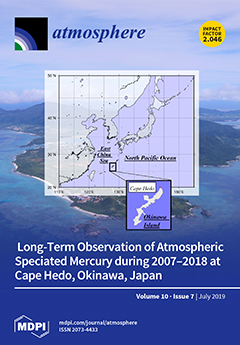As the new core region of the haze pollution, the terrain effect of sub-basin and water networks over the Twin-Hu Basin (THB) in the Yangtze River Middle-Reach (YRMR) had great impacts on the variations and distributions of air pollutants. In this study, trace gases (NH
3, HNO
3, and HCl), water-soluble ions (WSIs), organic carbon (OC), and elemental carbon (EC) were measured in PM
2.5 from 9 January to 27 January 2018, in Wuhan using monitoring for aerosols and gases (MARGA) and a semi-continuous OC/EC analyzer (Model RT-4). The characteristics of air pollutants during a haze episode were discussed, and the PM
2.5 sources were quantitatively analyzed on haze and non-haze days using the principal component analysis/absolute principal component scores (PCA/APCS) model. The average PM
2.5 concentration was 122.61 μg·m
−3 on haze days, which was 2.20 times greater than it was on non-haze days. The concentrations of secondary water soluble ions (WSIs) including NO
3−, SO
42−, and NH
4+ increased sharply on haze days, which accounted for 91.61% of the total WSIs and were 2.43 times larger than the values on non-haze days. The heterogeneous oxidation reactions of NO
2 and SO
2 during haze episodes were proven to be the major sources of sulfate and nitrate in PM
2.5. On haze days, the concentrations of EC, primary organic carbon (POC), and secondary organic carbon (SOC) were 1.68, 1.69, and 1.34 times larger than those on non-haze days, the CO, HNO
3, and NH
3 concentrations enhanced and relatively low SO
2, O
3, and HNO
2 levels were observed on haze days. The diurnal variations of different pollutants distinctly varied on haze days. The PM
2.5 in Wuhan primarily originated from the secondary formation, combustion, dust, industry, and vehicle exhaust sources. The source contributions of the secondary formation + combustion sources to PM
2.5 on haze days were 2.79 times larger than the level on non-haze days. The contribution of the vehicle exhaust + combustion source on haze days were 0.59 times the value on non-haze days. This description is supported by a summary of how pollutant concentrations and patterns vary in the THB compared to the variations in other pollution regions in China, which have been more completely described.
Full article





